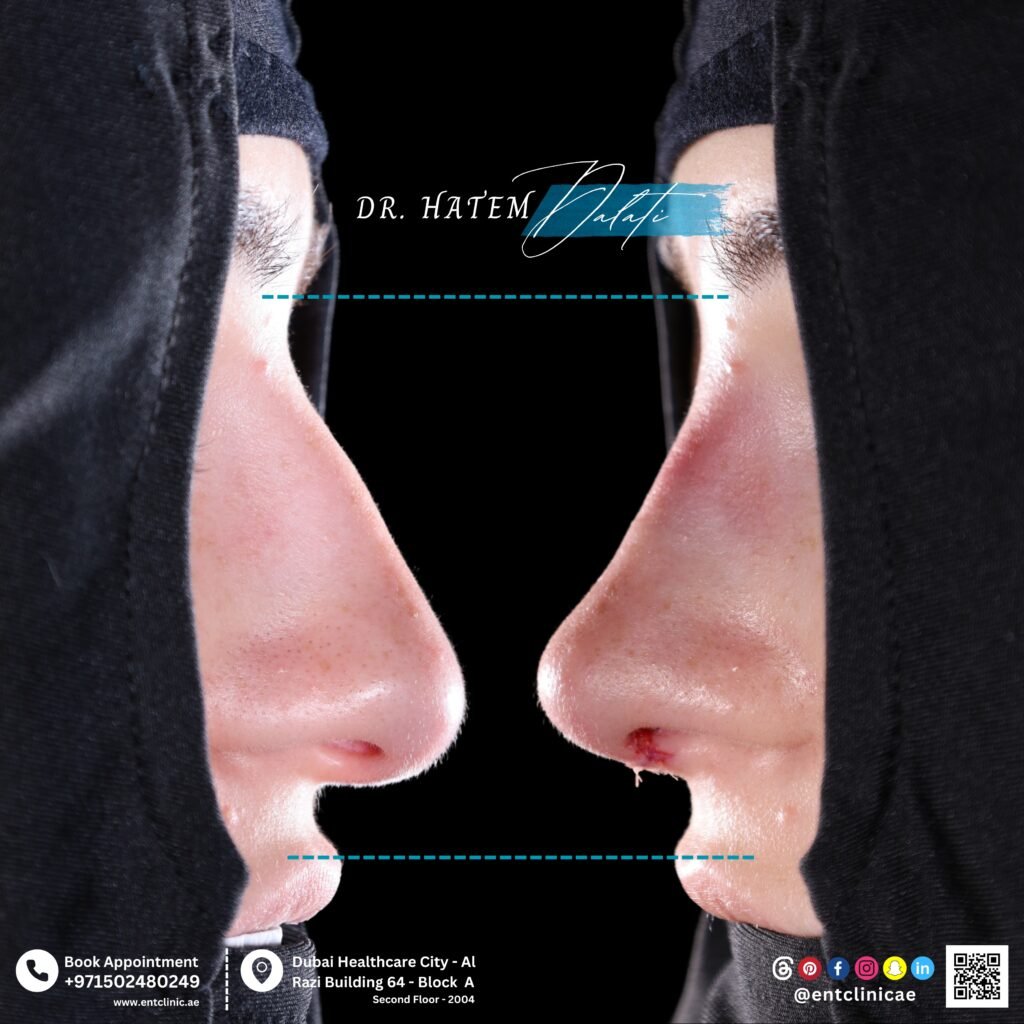
Understanding Nasal Adhesions After Rhinoplasty: Causes, Symptoms & Prevention | Dubai ENT Clinic 👃🩺
Rhinoplasty is one of the most popular cosmetic and functional surgeries worldwide. While it usually brings excellent results, some patients may experience a complication known as nasal adhesions (synechiae). These occur when scar tissue forms inside the nasal cavity and causes unwanted connections between structures. At Dubai ENT Clinic, our consultant helps patients understand, prevent, and treat adhesions for a healthy recovery.
What Are Nasal Adhesions? 🤔
Nasal adhesions are bands of scar tissue that form inside the nose, most commonly between the nasal septum and the turbinates (side walls). This creates a blockage in the nasal airway, making it harder to breathe.
👉 Small adhesions may go unnoticed, but larger ones can significantly affect nasal function and may require medical treatment.
Causes of Nasal Adhesions After Rhinoplasty ⚠️
- Post-Surgical Trauma: Healing tissues inside the nose may stick together if raw surfaces are left exposed.
- Excessive Scar Tissue Formation: Some patients naturally produce more scar tissue, increasing the risk.
- Inadequate Spacing During Healing: Lack of proper splints or stents can lead to internal structures fusing together.
- Infections or Chronic Inflammation: Post-operative infection can accelerate adhesion formation.
- Poor Post-Operative Care: Skipping saline washes or not attending follow-ups can worsen healing.
Symptoms of Nasal Adhesions 👃
- Persistent nasal obstruction or difficulty breathing
- Reduced or lost sense of smell
- Recurrent sinus infections
- Congested feeling despite clear passages
- Snoring or sleep disruption due to blocked airflow
How to Prevent Nasal Adhesions ✅
At ENT Clinic of Excellence, our surgeon takes preventive measures to reduce adhesion risk:
- Proper Surgical Technique: Gentle handling of tissues minimizes trauma.
- Nasal Splints/Stents: Used during recovery to keep nasal passages separated.
- Regular Saline Irrigation 💧: Keeps nasal passages clean and reduces inflammation.
- Timely ENT Follow-Ups: Early detection allows simple adhesiolysis (release of adhesions) before they worsen.
- Infection Control: Quick treatment of infections lowers scarring risk.
Treatment for Nasal Adhesions 💉
If adhesions do form, treatment options include:
- Minor In-Office Procedure (Adhesiolysis): ENT specialists/consultants carefully release adhesions using delicate instruments.
- Revision Surgery (in severe cases): Needed when adhesions cause significant obstruction or repeated problems.
Conclusion
Nasal adhesions after rhinoplasty can be distressing, but with proper care and timely treatment, they are manageable. At Dubai ENT Clinic, Dr. Hatem Dalati ensures patients receive the best surgical techniques and follow-up care to prevent complications and support smooth healing.
📍 Location: ENT Clinic of Excellence, Dubai Healthcare City
📞 Contact Us or Chat with us on WhatsApp 📲
🌐 Visit our website: entclinic.ae
📱 Follow us for more ENT & Rhinoplasty tips: Instagram | YouTube | TikTok
👨⚕️ About Dr. Hatem Dalati
Dr. Hatem Dalati is a leading ENT Consultant and Rhinoplasty Surgeon in Dubai. With years of surgical experience and international training, he is recognized for delivering natural rhinoplasty results that enhance facial harmony and improve breathing. Patients across the UAE trust his precision, artistry, and commitment to patient-focused care.